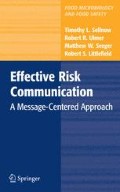Access this chapter
Tax calculation will be finalised at checkout
Purchases are for personal use only
References
Beck, U. (1992). Risk society: Towards a new modernity. Thousand Oaks, CA: Sage.
Chess, C. (2001). Organizational theory and stages of risk communication. Risk Analysis 21, 179– 188.
Chess, C., & Clarke, L. (2007, September). Facilitation of risk communication during the anthrax attacks of 2001: The organizational backstory. American Journal of Public Health 97, 1578– 1583.
Doeg. C. (2005). Crisis management in the food and drinks industry: A practical approach(2nd ed.). New York: Springer-Science + Media, Inc.
Frewer, L. J., Scholderer, J., & Bredahl, L. (2003). Communicating about the risks and benefits of genetically modified foods: The mediating role of trust. Risk Analysis 23, 1117–1133.
Gordon, J. (2003). Risk communication and foodborne illness: Message sponsorship and attempts to stimulate perceptions of risk. Risk Analysis 23, 1287–1296.
Griffin, R. J., Neuwirth, K., Dunwoody, S., & Giese, J. (2004). Information sufficiency and risk communication. Media Psychology 6, 23–61.
Hamilton, J. D. (2003). Exploring technical and cultural appeals in strategic risk communication: The Fernald radium case. Risk Analysis 23, 291–301.
Heath, R. L. (1995). Corporate environmental risk communication: Cases and practices along the Texas Gulf Coast. In B. R. Burelson (Ed.), Communication Yearbook 18 (pp. 255–277). Thousand Oaks, CA: Sage.
Heath, R. L., Bradshaw, J., & Lee, J. (2002). Community relationship building: Local leadership in the risk communication infrastructure. Journal of Public Relations Research, 14, 317–353.
Heath, R. L., & Palenchar, M. (2000). Community relations and risk communication: A longitudinal study of the impact of emergency response messages. Journal of Public Relations Research 12(2), 131–161.
Horlick-Jones, T., Sime, J., & Pidgeon, N. (2003). The social dynamics of environmental risk perception: Implication for risk communication research and practice. In N. Pidgeon, R. E. Kasper-son, & P. Slovic (Eds.), The social amplification of risk(pp. 262–285). Cambridge, United Kingdom: Cambridge University Press.
Kahlor, L., Dunwoody, S., Griffin, R. J., Neuwirth, K., & Giese, J. (2003). Studying heuristic-systematic processing of risk communication. Risk Analysis 23, 355–367.
Kasperson, R. E., Ortwin, R., Slovic, P., Brown, H. S., Emel, J., Goble, R., Kasperson, J. X., & Ratick, S. (2000). The social amplification of risk: A social framework. In P. Slovic, (Ed.), The perception of risk(pp. 232–245). London: Earthscan Publications Ltd.
Kasperson, J. X., Kasperson, R. E., Pidgeon, N., & Slovic, P. (2003). The social amplification of risk: Assessing fifteen years of research and theory. In N. Pidgeon, R. E. Kasperson, & P. Slovic (Eds.), The social amplification of risk(p. 13–46). Cambridge, United Kingdom: Cambridge University Press.
Leiss, W. (2003). Searching for the public policy relevance of the risk amplification framework. In N. Pidgeon, R. E. Kasperson, & P. Slovic (Eds.), The social amplification of risk(pp. 355–373). Cambridge, United Kingdom: Cambridge University Press.
McComas, K. A. (2003). Citizen satisfaction with public meetings used for risk communication. Journal of Applied Communication Research 31, 164–184.
Mead, P. S., Slutsker, L., Dietz, V., McCaig, L. F., Bresee, J. S., Shapiro, C., Griffin, P. M., & Tauxe, R. V. (1999). Food-related illness and death in the United States. Emerging Infectious Diseases, 5, 607–625.
Mitroff, I. I., & Anagnos, G. (2001). Managing crises before they happen: What every executive and manager needs to know about crisis management. New York: AMACOM.
Murdock, G., Pets, J., & Horlick-Jones, T. (2003). After amplification: Rethinking the role of media in risk communication. In N. Pidgeon, R. E. Kasperson, & P. Slovic (Eds.) The social amplification of risk(pp. 262–285). Cambridge, United Kingdom: Cambridge University Press.
National Research Council (1989). Improving risk communication. Washington, D.C.: National Academy Press.
Palenchar, M. J., & Heath, R. L. (2002). Another part of the risk communication model: Analysis of communication processes and message content. Journal of Public Relations Research 14(2), 127–158.
Palenchar, M. J., Heath, R. L., & Orberton, E. M. (2005). Terrorism and industrial chemical production: A new era of risk communication. Communication Research Reports 22(1), 59–67.
Perelman, C., & Olbrechts-Tyteca, L. (1969). The new rhetoric: A treatise on argumentation. London: University of Notre Dame Press.
Poumadere, M., & Mays, C. (2003). The dynamics of risk amplification and attenuation in context: A French case study. In N. Pidgeon, R. E. Kasperson, & P. Slovic (Eds.), The social amplification of risk(pp. 209–242). Cambridge, United Kingdom: Cambridge University Press.
Sandman, P. (2000). Open communication. In E. Mather, P. Stewart, & T. Ten Eyck (Eds.), Risk communication in food safety: Motivating and building trust. East Lansing: National Food Safety and Toxicology Center, Michigan State University.
Scherer, C. W., & Juanillo, N. K. (2003). The continuing challenge of community health risk management and communication. In T. L. Thompson, A. Dorsey, K. Miller, & R. Parrott (Eds.), Handbook of health communication(pp. 221–239). Mahwah, NJ: Lawrence Erlbaum.
Seeger, M. W., Sellnow, T. L., & Ulmer, R. R. (2003). Communication and organizational crisis. Westport, CT: Praeger.
Slovic, P. (1987). Perception of risk. Science 236(4799), 280–285.
Slovic, P. (2000). Introduction and overview. In P. Slovic, (Ed.), The perception of risk(pp. xxi– xxxvii). London: Earthscan Publications Ltd.
Williams, D. E., & Olaniran, B. A. (1998). Expanding the crisis planning function: Introducing elements of risk communication to crisis communication practice. Public Relations Review 24, 387–400.
Witte, K. (1995). Generating effective risk messages: How scary should your risk communication be? In B. R. Burelson (Ed.), Communication Yearbook 18 (pp. 229–254). Thousand Oaks, CA: Sage.
Rights and permissions
Copyright information
© 2009 Springer Science+Business Media, LLC
About this chapter
Cite this chapter
(2009). Introducing a Message-Centered Approach to Risk Communication. In: Effective Risk Communication. Food Microbiology and Food Safety. Springer, New York, NY. https://doi.org/10.1007/978-0-387-79727-4_1
Download citation
DOI: https://doi.org/10.1007/978-0-387-79727-4_1
Publisher Name: Springer, New York, NY
Print ISBN: 978-0-387-79726-7
Online ISBN: 978-0-387-79727-4
eBook Packages: Chemistry and Materials ScienceChemistry and Material Science (R0)

